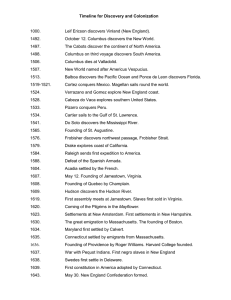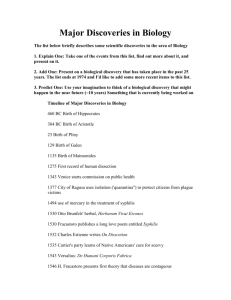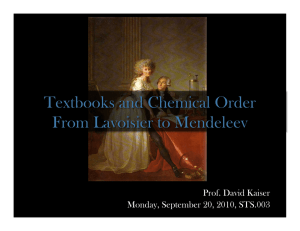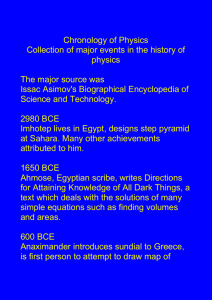SCIENTISTS TIMELINE
advertisement
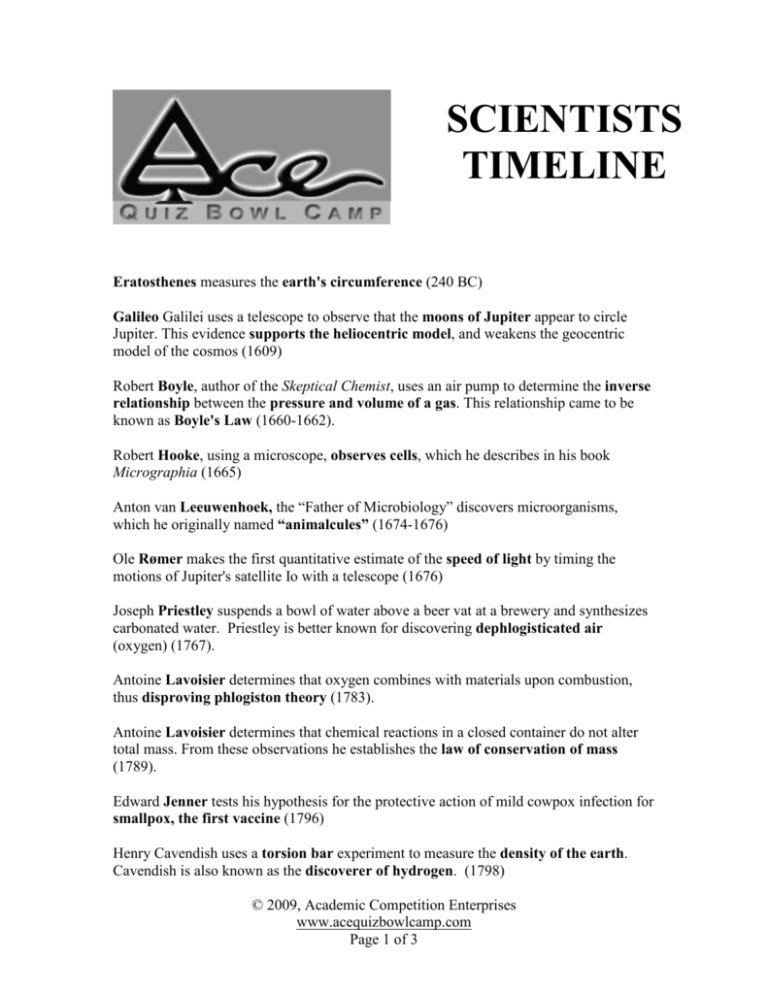
SCIENTISTS TIMELINE Eratosthenes measures the earth's circumference (240 BC) Galileo Galilei uses a telescope to observe that the moons of Jupiter appear to circle Jupiter. This evidence supports the heliocentric model, and weakens the geocentric model of the cosmos (1609) Robert Boyle, author of the Skeptical Chemist, uses an air pump to determine the inverse relationship between the pressure and volume of a gas. This relationship came to be known as Boyle's Law (1660-1662). Robert Hooke, using a microscope, observes cells, which he describes in his book Micrographia (1665) Anton van Leeuwenhoek, the “Father of Microbiology” discovers microorganisms, which he originally named “animalcules” (1674-1676) Ole Rømer makes the first quantitative estimate of the speed of light by timing the motions of Jupiter's satellite Io with a telescope (1676) Joseph Priestley suspends a bowl of water above a beer vat at a brewery and synthesizes carbonated water. Priestley is better known for discovering dephlogisticated air (oxygen) (1767). Antoine Lavoisier determines that oxygen combines with materials upon combustion, thus disproving phlogiston theory (1783). Antoine Lavoisier determines that chemical reactions in a closed container do not alter total mass. From these observations he establishes the law of conservation of mass (1789). Edward Jenner tests his hypothesis for the protective action of mild cowpox infection for smallpox, the first vaccine (1796) Henry Cavendish uses a torsion bar experiment to measure the density of the earth. Cavendish is also known as the discoverer of hydrogen. (1798) © 2009, Academic Competition Enterprises www.acequizbowlcamp.com Page 1 of 3 Thomas Young uses the double-slit experiment to demonstrate the wave-particle duality of light. (1801) Humphry Davy uses electrolysis to isolate elemental potassium, sodium, calcium, strontium, barium, magnesium, and chlorine (1807-1810). Joseph Louis Gay-Lussac studies reactions among gases and determines that their volumes combine chemically in simple integer ratios (1809). Hans Christian Ørsted discovers the connection of electricity and magnetism by experiments involving a compass and electric circuits. This is later termed electromagnetism (1820) Robert Brown studies very small pollen particles in water under the microscope and observes Brownian motion which was later named in his honor (1827). Friedrich Wöhler synthesizes the organic compound urea using inorganic reactants, disproving the application of vitalism to chemical processes (1828). Thomas Graham measures the rates of effusion for different gases and establishes Graham's law of effusion and diffusion (1833). Christian Doppler arranges to have trumpets played from a passing train. The groundobserved pitch was higher than that played when the train was approaching then lower than that played as the train passed and moved away, demonstrating the Doppler Effect (1845) Léon Foucault's namesake Foucault pendulum is first exhibited. It demonstrates the Coriolis effect and the rotation of the Earth (1851) Gregor Mendel's experiments with the garden pea led him to surmise many of the fundamental laws of genetics (dominant vs recessive genes, the 1-2-1 ratio, etc). His work is best summarized with the Law of Segregation and the Law of Independent Assortment (1856-1863) Louis Pasteur uses S-shaped flasks to prevent spores from contaminating broth, disproving the theory of Spontaneous Generation (also known as abiogenesis). This experiment was an extension of the rancid meat experiment of Francesco Redi. (1861) Edwin Hall discovers a voltage across a conductor with a transverse applied magnetic field, the Hall Effect (1879) Louis Pasteur inoculates Joseph Meister after the nine year old was bitten by a rabid dog. This is the first successful vaccine against rabies. (1885) © 2009, Academic Competition Enterprises www.acequizbowlcamp.com Page 2 of 3 Michelson-Morley experiment exposes weaknesses in the then-accepted theory of luminiferous ether. (1887) Svante Arrhenius determines the impact of temperature on reaction rates and formulates the concept of activation energy. (1889) William Ramsay and Lord Rayleigh (John Strutt) isolate the noble gases (1894-1898). Henri Becquerel, Marie Curie, and Pierre Curie discover radioactivity and describe its properties. (1896) Joseph John Thomson's cathode ray tube experiments (discovers the electron and its negative charge) (1897) Robert Millikan's oil-drop experiment, suggests that electric charge occurs as quanta (whole units), (1909) Heike Kamerlingh Onnes demonstrates superconductivity (1911) Ernest Rutherford's gold foil experiment demonstrates that the positive charge and mass of an atom is concentrated in a small, central atomic nucleus, disproving the thenpopular plum pudding model of the atom (1911) Glenn Theodore Seaborg creates and isolates five transuranium elements. He reorganizes the periodic table to its current form. (1941-1950). Alexander Fleming isolates penicillin from bread mold, winning him the Nobel Prize for Medicine (1944) Barbara McClintock breeds maize plants for color, which leads to the discovery of transposons or jumping genes. (1944) John Bardeen, William Shockley, and Walter Brattain fabricate the first working transistor at Bell Labs(1947) Melvin Calvin and Andrew Benson delineate the path of carbon in photosynthesis using Chlorella and carbon dioxide labeled with carbon-14, winning the 1961 Nobel Prize in Medicine. (1961) Arno Penzias and Robert Wilson detect the cosmic microwave background radiation, giving support to the theory of the Big Bang (1964) © 2009, Academic Competition Enterprises www.acequizbowlcamp.com Page 3 of 3
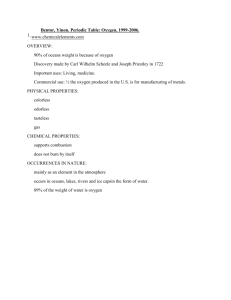

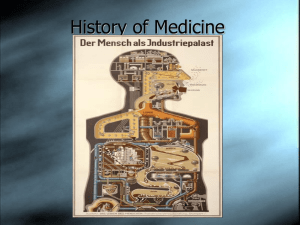

![Title of the Presentation Line 1 [36pt Calibri bold blue] Title of the](http://s2.studylib.net/store/data/005409852_1-2c69abc1cad256ea71f53622460b4508-300x300.png)
![[Enter name and address of recipient]](http://s3.studylib.net/store/data/006894526_1-40cade4c2feeab730a294e789abd2107-300x300.png)
